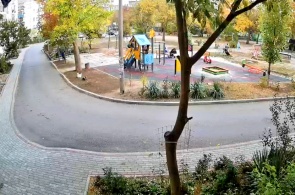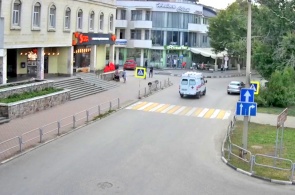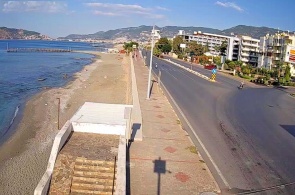Railway station square 1. Webcams of Feodosia
Feodosia is a city with a rich history and the greatest cultural heritage. Founded before our era, this city has become home to representatives of a wide variety of nationalities and religions. That is why, in Feodosia, there is such a wide variety of religious buildings.Many centuries ago, Theodosia was compared to the great capital of the Ottoman Empire - Istanbul. Several monuments have survived from that era to the present day. Among them is the Mufti-Jami Mosque, which was built in the 17th century. The building was rebuilt several times, but the dome and minarets remained the same as in the original building.
After the annexation of Crimea to the Russian Empire, an Armenian temple was located within the walls of the mosque. But at the end of the 20th century, the primary purpose of the building was restored.
The mosque has a square layout and is inferior to Turkish counterparts only in size. At the same time, the construction and decoration of the object were made in the best traditions of Ottoman religious architecture.
The building has three entrances. The interior is decorated with old wall paintings. Previously, at the entrance to the temple there was a mausoleum for representatives of noble families, but it has not survived to this day.
There is also an Armenian temple in Feodosia in the name of St. Sergius. He was canonized after a painful death for his faith. Opinions about the date of the construction of the shrine differed. Some believe that the church originated in the XIV century. According to another version, it was built in the 9th-10th centuries.
Ascetic on the outside, the building also has a very restrained interior decoration.
In the 19th century, the church was practically destroyed by fire. However, thanks to the donations of Ivan Aivazovsky, an Armenian by origin, the temple was restored.
The next test came in the 20th century, when the church was turned into a museum by the Bolsheviks. The object was returned to the Armenian community in the 70s of the last century.
Another church in Feodosia, built by the Armenians, bears the name of St. George. It was built in the XIV century and was the main temple of the St. George monastery complex. But after the conquest of the peninsula by the Turks, the church and monastery were closed. The temple was restored only after the annexation of the Crimea to the Russian Empire.
In Soviet times, there was a furniture warehouse here, and later the object was abandoned. Despite the fact that the Armenian community tried to raise funds for the restoration of the shrine, there was not enough money.
For some period the church housed an exhibition about the temples of the city. But now, unfortunately, the building is gradually being destroyed.
More details
Camera with a view of the Chernobyl Square in Feodosia (Crimea). The lens captures a spacious, picturesque area, which has become one of 5 public locations, landscaped within the framework of the regional and all-Russian projects "Formation of a comfortable urban environment" and "Housing and urban environment". The broadcast is broadcast in real time.
Feodosiya, Crimea
11.11.21
Webcam with a view of the adjoining territory at 12 Starshinova Street in Feodosia (Crimea). The lens captures parking for cars and a cozy front garden. Behind it there is a sports ground, which appeared here relatively recently, as part of the state improvement program. The broadcast is carried out in real time.
Feodosiya, Crimea
10.11.21
Live webcam is installed at Simferopol highway, 1 in Feodosia (Crimea). The lens of the device captures a fragment of a modern playground and the adjoining territory, which was recently landscaped within the framework of the state program. The broadcast is carried out in real time.
Feodosiya, Crimea
09.11.21
The webcam is installed in the courtyard of the house number 28A on the Crimean street in Feodosia (Crimea). The lens covers a landscaped area near the house, which was reconstructed within the framework of the state program. Here is the MFC, tax office, post office. The broadcast is carried out in real time
Feodosiya, Crimea
07.11.21
Camera overlooking the Monument to St. Andrew the First-Called in Feodosia. The monument is located next to Karl Marx Street. The lens captures a recently landscaped square and a monument representing a cult sculptural image. Nearby there is a parking lot, an extensive public garden. The broadcast is broadcast in real time.
Feodosiya, Crimea
06.11.21
The camera is located in the courtyard of the house number 42 on the street. Gorky in Feodosia (Crimea). The lens captures a landscaped house area with a modern playground, cobbled sidewalks and flower beds. The landscaping of the courtyard took place quite recently, and now you can watch the renovated recreational area in real time.
Feodosiya, Crimea
06.11.21
The device is installed at house No. 5 on Zheleznodorozhnaya Street in Feodosia (Crimea). The lens captures a cozy adjoining territory with a playground and flower beds, which was recently landscaped within the framework of the state program. Today, in real time, you can observe the well-groomed courtyard and keep abreast of what is happening in the distant sunny town.
Feodosiya, Crimea
05.11.21
The camera overlooks the monument to the hero of the Caucasian War of the 19th century - General Pyotr Kotlyarevsky (Feodosia, Crimea). The monument adorns the embankment of the city, next to the house where the military leader lived, who did not lose a single battle. The monument is an equestrian sculpture placed on a granite pedestal. There is a spacious area around the monument.
Feodosiya, Crimea
07.10.21
Camera overlooking the monument to Sokovnin in Feodosia (Republic of Crimea). The lens covers the wide roadway and the adjacent square, where the monument is installed. The bust was installed in 2002, not far from the Good Genius fountain. N.M. Sokovnin is a vice admiral who became famous in the Crimean War during the defense of Sevastopol.
Feodosiya, Crimea
07.10.21
Live webcam is positioned in the Feodosia park "Yubileiny" (Republic of Crimea). The lens covers a spacious, well-maintained alley with flower beds and bushes. In the background you can see the Good Genius fountain, which was created in honor of I.K. Aivazovsky, who bought a land plot for the city, on which a fresh water source was located.
Feodosiya, Crimea
07.10.21
The camera is positioned in the Crimean city of Feodosia. The lens of the device captures a large store "Novy Svet" and the adjacent territory. The object is located on the street. Nazukin 9/1. There is a shop, cafe and hotel here. The view opens from the side of the road. The broadcast is broadcast in real time.
Feodosiya, Crimea
06.10.21
Webcam overlooking the monument to I.K. Aivazovsky, near the gallery founded by the artist (Feodosia, Crimea). The lens covers the spacious street, the museum building and the monument itself. The gallery was opened in 1880. It includes 417 paintings by Aivazovsky, representing the most extensive collection of paintings by the marine painter in the world. The broadcast can be watched in real time.
Feodosiya, Crimea
06.10.21
The camera is positioned in the resort city of Feodosia (Republic of Crimea). The paratroopers' embankment gets into the lens of the device. In the background you can see the cargo cranes of the Feodosia port and the Ferris wheel. On the left, the overview covers the Black Sea. The broadcast is carried out in real time.
Feodosiya, Crimea
06.10.21
The webcam is installed in the city of Feodosia (Republic of Crimea) with a view of the city port and the lighthouse. The lens covers the strip of the beach and the embankment adjacent to it. The port's cargo cranes and a lighthouse are visible in the background. There is also a Ferris wheel with amazing views of the sea and urban surroundings. The broadcast is conducted online.
Feodosiya, Crimea
05.10.21
Camera overlooking General Gorbachev Street in Feodosia (Republic of Crimea). The overview covers a large pedestrian zone, an abundance of shops and cafes. Here you can order a pleasure van or take a walk. The angle opens from the side of the 2nd crossing. The broadcast is carried out in real time.
Feodosiya, Crimea
05.10.21
popular camerasshow all
Sultanahmet or Blue mosque is a work of art of Turkish-Islamic architecture. Its construction began in 1609, the construction work took seven years to a 19-year-old Sultan. The name of the mosque was, due to its interesting and unique finish.
Istanbul, Turkey
Stavanger, a town in the commune of Norway, located in the South-Western part of the country, on the Peninsula, rich in minerals. Tanager combines the influence of foreign organisations such as NATO and oil companies. The camera will shoot the harbour and the promenade of the city.
Stavanger, Norway
A webcam broadcasts the district of Tosmur - quiet location in the Eastern part of Alanya, located only five kilometres from the city centre. Its rural way of life and the beauty of untouched nature attract tourists.
Alanya, Turkey
Shark Island or in English of Shark island, located in the harbour city of Sydney, the suburb of Point Piper. The locals, the natives named the island Boambilly, which translated means Shark island. After all, this name is not casual, because it's mean and looks like a shark fin.
Sydney, Australia
The webcam is installed on site Alva. Tsaghkadzor ski resort town in Armenia. Tsaghkadzor is a beautiful mountainous area among deciduous forests, with a pleasant winter climate, and clean fresh air. The highest point is 1800 meters. The truss type is a classic, divided into three.
Tsakhkadzor, Armenia





















